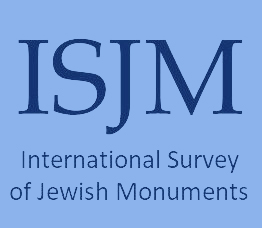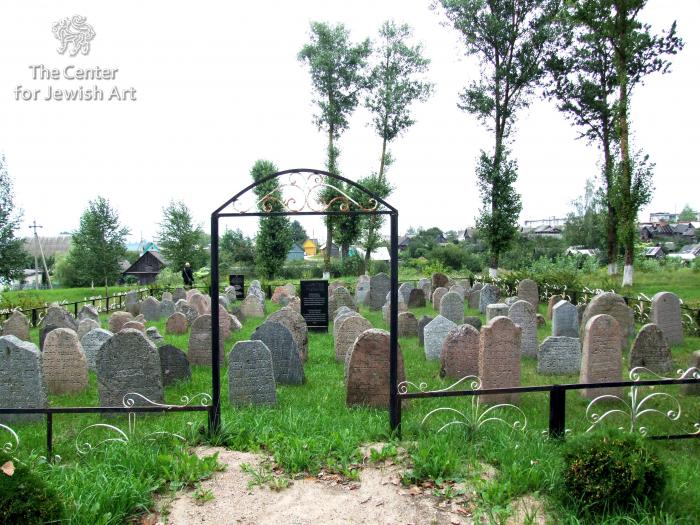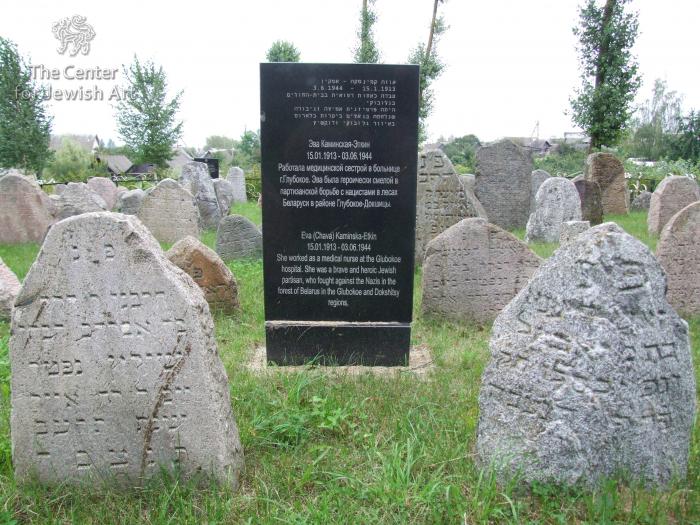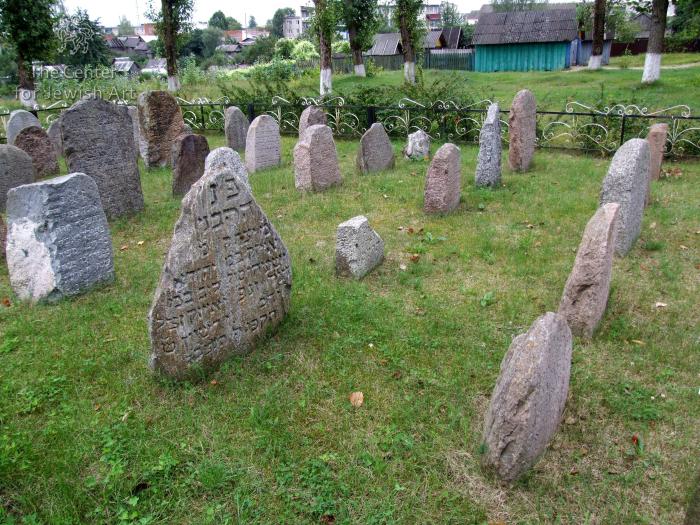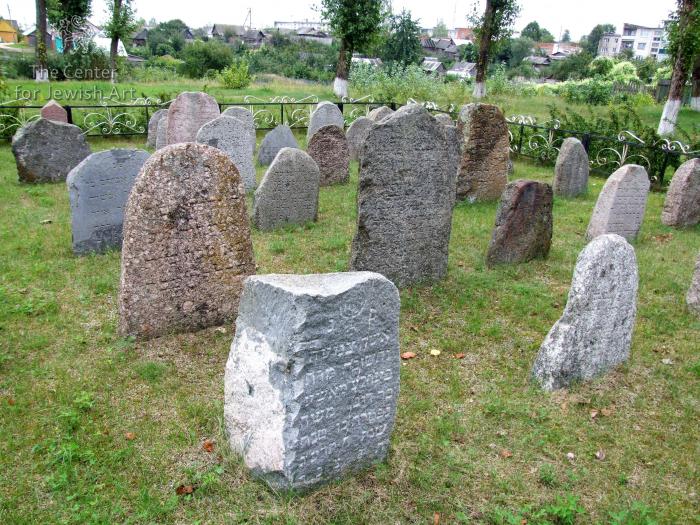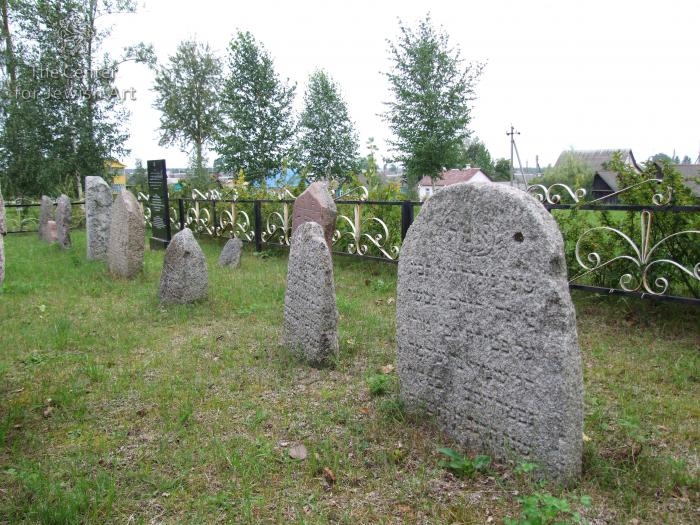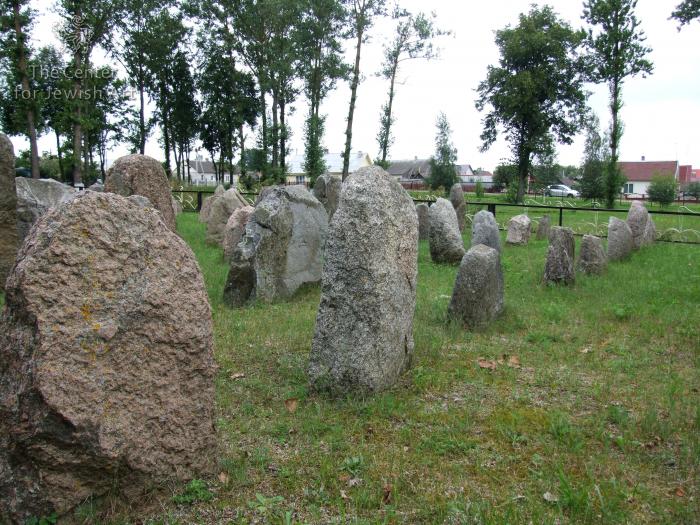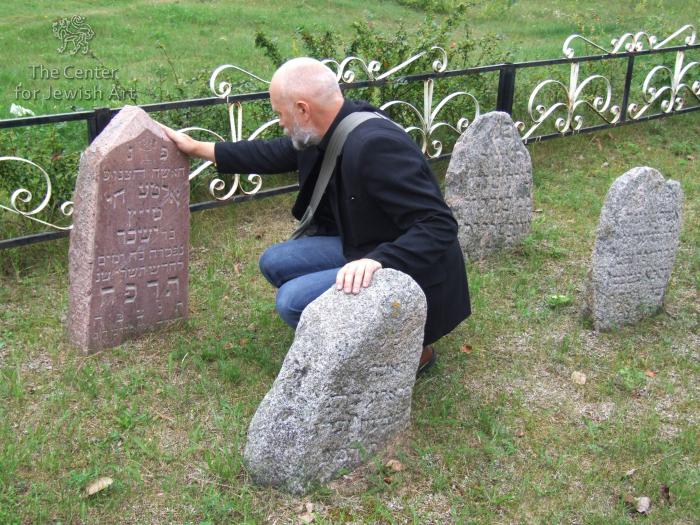Obj. ID: 32644 The Monument at the Jewish Cemetery in Dokshitsy, Belarus, 2000s

Memorial name:
No official name.
Who is Commemorated?
Jewish Holocaust victims from Dokshitsy.
Description
The monument is erected at the center of the Jewish lapidarium, created at the estimated age of the former Jewish cemetery. It is shaped like a black granite stele on a base, at the foot of which there is another small granite grave marker with the Hebrew and Belarusian inscriptions. On one side, the surface of the stele bears two six-pointed stars, and the inscriptions in Yiddish, Belarusian, English, and Hebrew. On another side there are three additional inscriptions: in Hebrew, Russian, and English.
The monument's territory is surrounded by a fence.
Inscription
On the one side of the monument:
In Yiddish
לן זיי וויסן, אז ס׳איז געווען אמאל אזא שטעל ווי דאקשיץ
ווו יידיש לעבן הט געליבט.
שכנא קאנטאראוויטש
Translation: They should know that there was once a shtetl like Dokshtsy, where Jewish life flourished. Shehina Kantorovich.
In Belarussian
Каб памяталі, што некалі ў мястэчку Докшыцы
віравала яўрэйскае жыццё.
Шэхіна Кантаровіч
Translation: They should remember that once in the shtetl of Dokshtsy the Jewish life flourished. Shehina Kantorovich.
In English
They should know that there was once a shtetl like
Dokshitsy, where Jewish life flourished.
Shechina Kantorovich
On the grave marker:
In Hebrew
פ״נ
ישראל פרידמן
חנה בלוך
רזזל [רזל] פרידמן
וכל אלה ששמותם לא ידוע[ים]
[ש?]נרצחו במאורע הזה
אלול תש׳׳ה
ת׳ נ׳ צ׳ ב׳ ה
Translation: Here lie / Israel Freedman / Hana Bloch / Reizel Freedman / and all those whose names are unknown / and those who were killed in this event. / Elul 5705 / May their souls be bound in the bundle of life.
In Belarusian
Хана Блох
Ізраэль Фрыдман
Рэйзель Фрыдман
І ўсе тыя, хто быў забіты на гэтым месцы
І чье імёны нам невядомыя
Верасень 1941
Translation: Israel Freedman / Hana Bloch / Reizel Freedman / and all those who were killed at this site / And those whose names are unknown to us. / September 1941.
On the other side of the monument:
In Hebrew
אווה קמינסקה - אטקין
15.1.1913 - 3.6.1944
עבדה כאחות רפואית בבית-החולים
בגלובוקי
היתה פרטיזנית אמיצה וגיבורה
שנלחמה בנאצים ביערות בלארוס
באיזור גלובוקי ודוקשיץ
Translation: Eva Kaminska-Etkin / 15.1.1913 - 3.6.1944 / Worked as a medical nurse at the hospital / in Glubokoe. / Was a brave and heroic partisan, who fought against the Nazis in the forests of Belarus / in the Glubokoe and Dokshitsy region.
In Russian
Эва Каминская-Эткин
15.01.1913 - 03.06.1944
Работала медицинской сестрой в больнице
г. Глубокое. Эва была героически смелой в
партизанской борьбе с нацистами в лесах
Беларуси в районе Глубокое-Докшицы.
Translation: Eva Kaminskaya-Etkin / 15.01.1913 - 03.06.1944 / worked as a medical nurse in the hospital / of the town of Glubokoe. Eva was heroically brave in / a partisan fight against the Nazis in the forests / of Belarus in the Glubokoe-Dokshitsy region.
In English
Eva (Chava) Kaminska-Etkin
15.01.1913 - 03.06.1944
She worked as a medical nurse at the Glubokoe
hospital. She was a brave and heroic Jewish
partisan, who fought against the Nazis in the
forest of Belarus in the Glubokoe and Dokshitsy
regions.
Commissioned by
The victims' relatives.
The Wehrmacht entered Dokshitsy on 9 July, 1941. Their arrival was followed by a slew of anti-Jewish decrees, and in September of the same year, a ghetto was set up. Several mass killings took place. Following one of them, the survivors began to build underground shelters, hoping to hide during the next mass murder, which was imminent. On May 29, 1942, the Germans, aided by the auxiliary police, entered the Dokshitsy ghetto in order to liquidate it. However, this massacre dragged on for more than two weeks, as many Jews had hidden in bunkers, and it took the Nazis that much time to find all of them [Yad Vashem: The Untold Stories].
The memorialization of the Dokshitsy began in May 1968 when the local Soviet administration in Dokshitsy decided to set up a monument to the victims of the German occupation of the town. The area of the former sand quarry, which had been used by the Nazis as an execution site, was transformed into a small public garden and a sports ground. An official Soviet monument does not mention the ethnicity of the great majority of the people murdered there [Yad Vashem: The Untold Stories].
In 2008, some enthusiasts added a black marble stele to the existing monument that mentions the victims' nationality [Yad Vashem: The Untold Stories; Smilovitsky].
In the 2000s, the present stele was erected at the age of the former Jewish cemetery that, during wartime, turned into a killing site. Since the reconstruction of the cemetery is impossible, the lapidarium was created, at the center of which the monument stands.
"Dokszyce,"
Untold Stories - Murder Sites of Jews in Occupied Territories of the USSR (Yad Vashem project), https://collections.yadvashem.org/en/untold-stories/community/14622187.
Smilovitsky, Leonid, "Po sledam evreiskikh kladbishch Belarusi: Dokshitsy," Zhurnal-gazeta "Masterskaia," ed. Evgenii Berkovich., https://club.berkovich-zametki.com/?p=43947 (accessed February 12, 2024)



